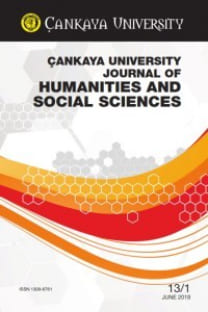Thackeray’in Çocukları: Gülme, Çocukluk ve Peri Masalının Büyü Bozumuna Uğratılışı
The Rose and The Ring, Viktorya döneminde gülme, on dokuzuncu yüzyılda çocukluk, realizm, peri masalı, Dickenscı gülmece
Thackeray’s Children: Laughter, Childhood, and Disenchanting The Fairy Tale
The Rose and The Ring, Victorian laughter, 19th century childhood, realism, fairy-tale, Dickensian laughter,
___
- Andrews, Malcolm. Dickensian Laughter: Essays on Dickens and Humour. Oxford University Press, 2013.
- Aristotle. Nichomachean Ethics. Translated by Roger Crisp. Cambridge University Press, 2004.
- Beattie, James. Essays: On the nature and immutability of Truth, in opposition to Sophistry and Scepticism. Edinburgh
- Calic, Marie-Janine. A History of Yugoslavia. Translated by Dona Geyer. Purdue University Press, 2019.
- Eagleton, Terry. The English Novel: An Introduction. Blackwell, 2005.
- Forster, E.M. Aspects of The Novel. Edited by Oliver Stallybrass. Pelican Books, 1985.
- Filmore, Parker. The Laughing Prince: A Book of Jugoslav Folk and Fairy Tales. Harcourt Brace and Company, 1921.
- Fleming, Patrick C. “The Rise of the Moral Tale: Children’s Literature, The Novel, and The Governess,” Eighteenth-Century
- Gray, Donald J. “The Uses of Victorian Laughter.” Victorian Studies, vol. 10, no.2, 1966, pp.145-176.
- Hunt, Peter. “Introduction: The expanding world of Children’s Literature Studies,” Understanding Children’s Literature,
- Jones, Stephen Swann. The Fairy Tale: The Magic Mirror of Imagination. Routledge, 2002.
- Lewis, C.S. The Discarded Image: An Introduction to Medieval and Renaissance Literature. Cambridge University Press,
- Morreall, John. Comic Relief: A Comprehensive Philosophy of Humour. Wiley-Blackwell, 2009.
- Moretti, Franco. The Way of The World: The Bildungsroman in European Culture. Verso, 1987.
- Newton, Michael, editor. Victorian Fairy Tales, Oxford University Press, 2015.
- Nussbaum, Martha C. The Fragility of Goodness: Luck and Ethics in Greek Tragedy and Philosophy. Cambridge University
- Praet, Stijn. “An Underdog in the Vanguard.” The Fairy-Tale Vanguard: Literary Self-Consciousness in a Marvelous Genre,
- Propp, Vladimir. Theory and History of Folklore. Translated by Ariadna Y. Martin and Richard P. Martin. University of
- Segel, Elizabeth Towne. “Truth and Authenticity in Thackeray.” The Journal of Narrative Technique, vol. 2, no.1, 1972, pp. 46-
- Sorensen, Gail D. “Thackeray’s The Rose and The Ring: A Novelist’s Fairy Tale.” Mythlore, vol. 15, no.3, 1989, pp. 37-43.
- Tatar, Maria. “Introduction.” The Cambridge Companion to Fairy Tales, edited by Maria Tatar, Cambridge University Press,
- Thackeray, W.M. The English Humourists of The Eighteenth Century and Charity and Humour, edited by Edgar F. Harden,
- Wood, Naomi. “Angelic, Atavistic, Human: The Child of The Victorian Period.” The Child in British Literature: Literary
- Construction of Childhood, Medieval and Contemporary, edited by Adrienne E. Gavin. Palgrave Macmillan, 2012.
- ISSN: 1309-6761
- Yayın Aralığı: Yılda 2 Sayı
- Başlangıç: 2004
- Yayıncı: Çankaya Üniversitesi
Julian Barnes’ ın Korkulacak Bir Şey Yok Adlı Eserinde Ölüm ve Ölüm Korkusu
Flaubert’in Papağanı Romanında Yazar, Otorite ve Özgünlük Arayışı
Mustafa Zeki ÇIRAKLI, Öznur YEMEZ
And Breathe Normally ve Anchor Baby adlı Filmlerde Afrikalı Göçmen Annelerin Kurgusal Hayatları
Edebiyat Kuramı, Biçimbilim ve Bilişsel Şiirbilim
Bilişsel Sözlük Bilim: İngilizce Devinim Fiillerinin Yeniden Düşünülmesi
Yas Kefenini Sökmek: Don DeLillo’nun The Body Artist Adlı Romanı
Thackeray’in Çocukları: Gülme, Çocukluk ve Peri Masalının Büyü Bozumuna Uğratılışı
